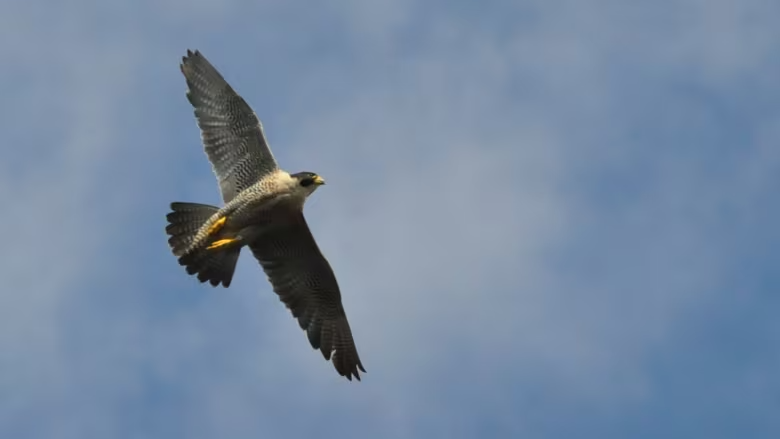Canada News
Yukon behind on protecting vulnerable species, study says

A peregrine falcon seen near Inuvik. N.W.T. Senior Yukon wildlife biologist defends territory’s protection practices saying that’s among the species the territory has been a leader in conserving. (Philippe Morin/CBC)
By
A new research review states the territory’s wildlife laws only covers five per cent of species
The Yukon is lagging behind other jurisdictions when it comes to safeguarding vulnerable species, according to a new national study.
The review, published in the research journal Facets, assessed species at risk law and how it’s being applied by province or territory. That legislation protects plants and animals teetering on disappearance. The paper found “considerable variation across jurisdictions, with shortcomings that result in inadequate protections for at-risk species.”
In the Yukon, the paper suggests things are looking relatively bleak. Unlike the Northwest Territories, the Yukon doesn’t have its own species at risk legislation, despite signing onto a 1996 accord agreeing to do so. While there are some protections under its Wildlife Act, which regulates hunting and trapping, the legislation only affects five per cent of species. The paper states that, with the exception of the federal system, there’s no legal obligation to manage — or recover — vulnerable species at the territorial level.
Lead author Susan Gordon, a researcher with the University of Ottawa, said this is a blind spot that carries a lot of risk. She said relying on the federal statute isn’t good enough. In the Yukon, the federal legislation applies to just eight per cent of the territory, she said.
“A lot of focus is on the federal level species at risk legislation, listings and protections, but the actual power of that legislation is limited in a lot of cases to Crown land,” Gordon said, noting some exceptions such as migratory birds like ducks.
“But outside of that, it’s all really up to the decisions that are made at the provincial or territorial level.”
Plants, fungi, fish excluded from existing laws
Carleton University researcher Marlena Warren, also an author on the study, said that while there are safeguards for wildlife in the Yukon, they don’t go far enough.
Four animals are listed under “specially protected wildlife,” she said, a category that prohibits hunting. That includes cougars, trumpeter swans and the gyrfalcon. There are exceptions in the case of Inuvialuit, who can legally harvest animals with the status.
Warren said that’s a positive, but the legislation excludes plants, fungi, insects and fish.
“The goal is to preserve biodiversity, so that would include all types of species. If you’re just focusing on a small group, you could be losing other species without even knowing,” she said.
The paper calls on the Yukon to list vulnerable species, protect habitat “across land ownership types,” and implement legislation.
What are other places doing?
Since 2009, the N.W.T. has had its own tailor-made legislation. Under that law, two boards work together to, if warranted, issue a designation and list it publicly. One of those groups, called the Species At Risk Committee, is made up of experts, including biologists and Indigenous people, who parse through information — for instance, biological data — on a given species and issue recommendations based on their findings.
Kristi Benson, a committee member, said that it boils down to having the right legislation, especially one with transparent processes available to the public.
“I think that having a local act is definitely going to make for better decision-making,” she said.
Benson said the Northwest Territories’ process could be seen as a guiding light.
The study, however, is critical of how this system works. The committee can recommend to the government that it conserve land or species. But the paper states that since the inception of the N.W.T’s legislation, the minister has never never escalated those recommendations.
Yukon ‘a national if not global leader’, biologist says
Thomas Jung, a senior wildlife biologist with the Yukon government, said biodiversity loss is a global problem that legislation alone can’t solve.
“The study is academic, in many senses, and it doesn’t really look at the bigger picture,” he said. “Really working on species at risk management involves a lot of on-the-ground work that’s not captured in this study.”
Jung said for decades the territory has worked with First Nations, the Inuvialuit, various boards and councils to protect species and land.
“We’ve been a national if not global leader in managing and conserving species like peregrine falcon, some of the rare, endemic plants and animals that occur in the Yukon,” he said.
Jung said that work happens through monitoring, research, and sharing information with developers.
Diane Gunter, director of strategic partnerships with Environment Yukon, acknowledges there are gaps in the territorial legislation, but she says those are being sorted out through the Yukon-Canada Nature Agreement.
Signed by Ottawa and the territory at the end of 2022, the agreement aspires to conserve 30 per cent of territorial land by the end of the decade. The accord also sets in motion work for Yukon to develop its own species at risk legislation, however any timeline for implementing the bill remains unclear.
“What we’re looking to do right now,” Gunter said, “is engage with our partners — Yukon First Nations, transboundary Indigenous governments groups — and looking at what is the best fit for Yukon in protecting species at risk?”
The federal government has set aside roughly $7.1 million to support the territory in doing so.
In a written statement, a spokesperson with Yukon’s department of environment said the majority of the territory’s more than 10,000 plants and animals are healthy.





















